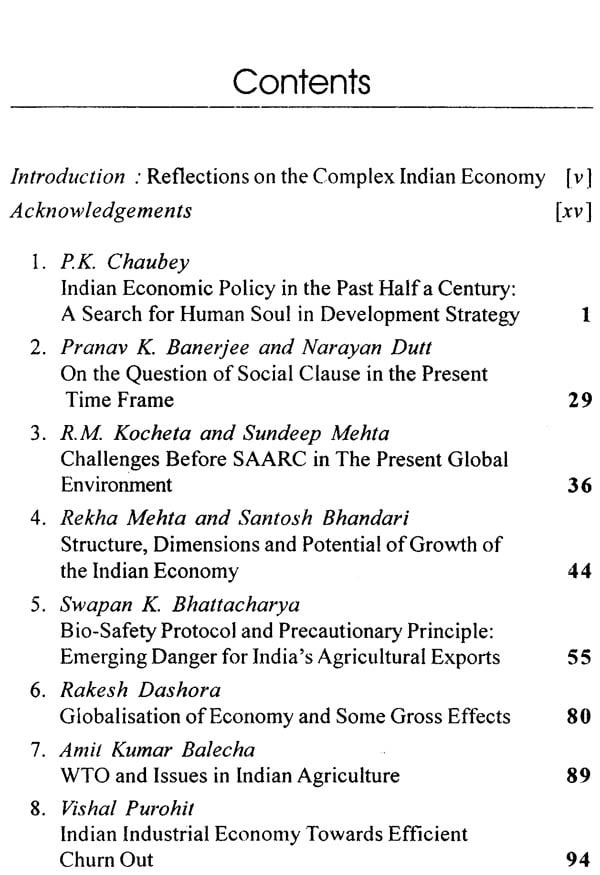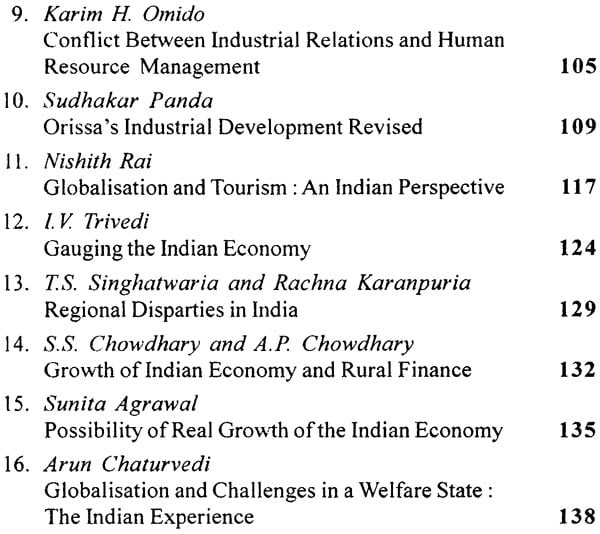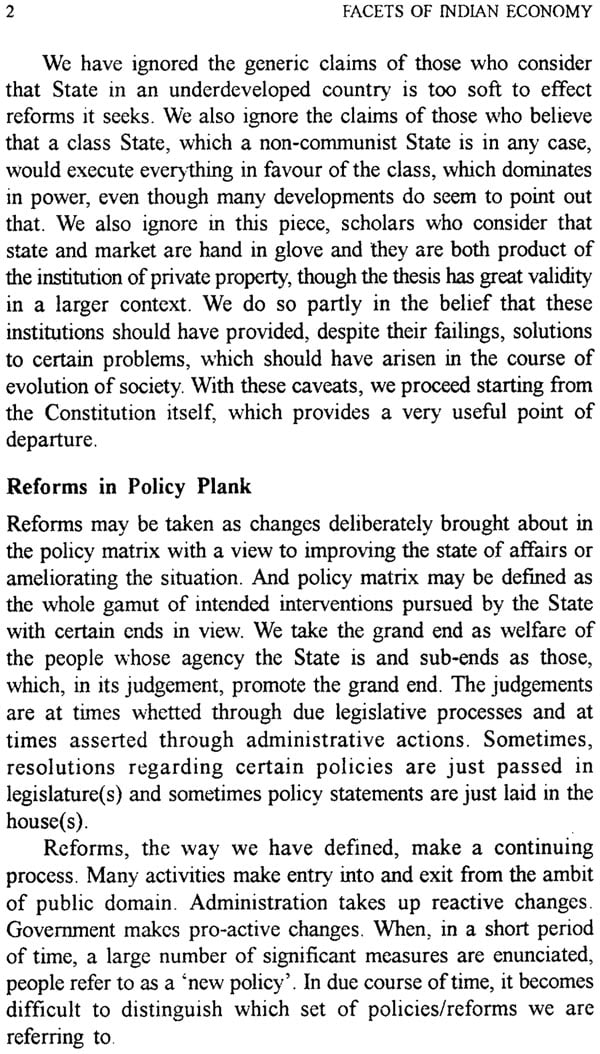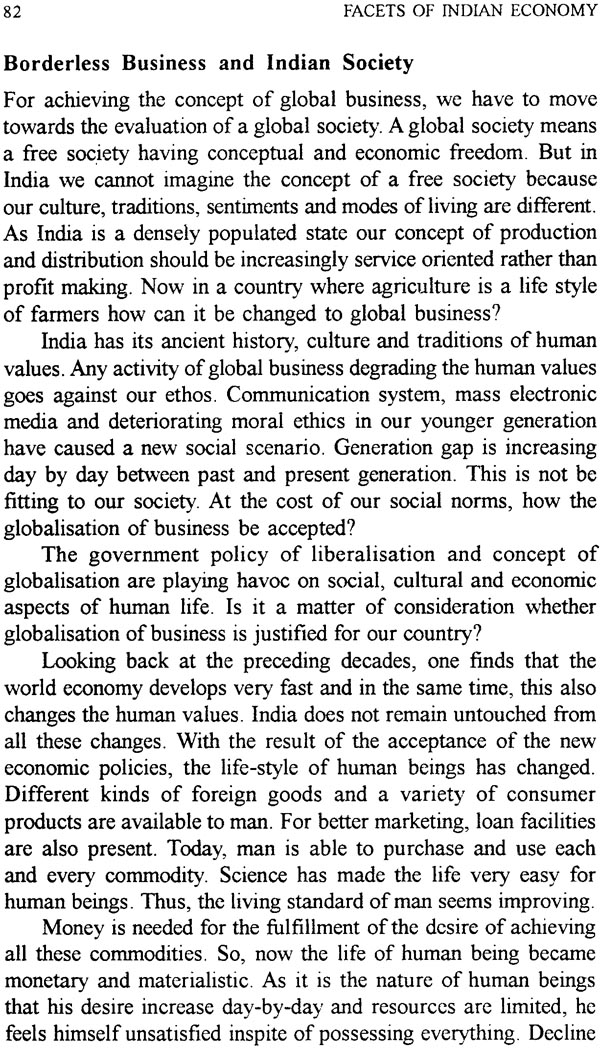
Facets of Indian Economy
Book Specification
| Item Code: | NAT399 |
| Author: | Pranav K. Banerjee |
| Publisher: | National Publishing House |
| Language: | ENGLISH |
| Edition: | 2010 |
| ISBN: | 8121401208 |
| Pages: | 152 |
| Cover: | HARDCOVER |
| Other Details | 9.00 X 6.00 inch |
| Weight | 290 gm |
Book Description
The Indian economy, with all its complexity, has a number of objectives which sometimes puzzle one while trying to establish clear and concrete linkages. It is, possibly, not very clear about the ultimate end product for a democracy like India where political upheavals, many a time, change the framework of the developmental process.
India, a country of more than 1 billion people, had its own kind of production function, its methodology and an economic system that grew over the decades. However, when the New Economic Reforms were launched in 1991, followed by signing of the GATT accord in 1994, the economy of India experienced a heavy jolt which resulted in a series of problems ranging from closure of industrial units to unemployment, among many others.
The most crucial fact that curbs a clear view of our economy is that there are great number of unmonitored areas which have not been satisfactorily understood and examined by relevant agencies. As a result, the Indian economy has come to a point, over a periods of crucial disorders, which has endless loose ends.
Nevertheless, the country is progressing very fast taking along all kinds of ups and downs and a series of critical opinions of the experts. The multi-faceted economy of India has its own share of growth in which Indianness of its realities is a solid area which, perhaps, cannot be replaced in a foreseeable future.
This book is the outcome of efforts of various contributors working on different issues of India's development to go through various issues of development in the country. It is hoped that the book will prove useful to the researchers, students of economics and to all those who are keenly interested in the development process of the country.
Pranav K. Banerjee, Reader in Economics at Delhi College of Arts and Commerce, University of Delhi, earlier taught at Indian Institute of Foreign Trade, New Delhi as professor and also at Rensseiaer Polytechnic Institute, Troy, NY as visiting fellow. He was invited by the Canadian Indian Studies Association to lecture in a number of schools. His other publications include :
• Indian Agricultural Economy : Financing Small Farmers
• Crisis of the Betrayed
• Essays in Technology, Development and the Third World
• Reflections on Development, Growth and Society
• Issues in Indo-US Trade and Economic Cooperation (ed.)
Reflections on the Complex Indian Economy The process of globalisation of the world economy has been so widely debated in the South and, to some extent, also in the North that it raises the question of a number of bottlenecks experienced by the developing world either implicitly or without a cover. India, a country of more than 1 billion people, had its own kind of production function, its methodology and an economic system that grew over the decades. However, when the New Economic Reforms were launched in 1991, followed by signing of the GATT accord in 1994, the economy of India experienced a heavy jolt which resulted in a series of problems ranging from closure of industrial units to unemployment, among many others. Ironically, a clear understanding of the Indian economy is unlikely to be a concrete reality, for the country does not have enough and adequate monitoring mechanism to get into the complexities of a system which has multiple facets of production function, distribution of income, investment procedure, lacunae in trade and market and a series of issues which have been coming into existence as and when they got opportunities. The most crucial fact that curbs a clear view of our economy is: there are great number of unmonitored areas which have not been satisfactorily understood and examined by relevant agencies. As a result, the Indian economy has come to a point, over a periods of crucial disorders, which has endless loose ends. The pertinent question that hits us is: How to understand the implicit areas of the economy linking it with all hitherto unexposed interlinks? Though it is the toughest exercise to plan development, possibly, we have no alternative to put forward. We have to understand without a pause that the economy's two prime segments-small farmers and landless labour, and sick industries-are two important variables which, despite a number of governmental efforts, look heavily pressurised. In India, small farmers and landless labour, along with their tribal and low caste components, are usually unorganised and in a highly worrisome state. Agriculture, as a prime occupation, has been country's occupational resource for centuries, but it has not been able to transform its condition. At this juncture, the question that arises is: Whether the rural sector can be given training in agriculture itself or in some other areas and some workable methods can be found preferably with domestic resources, to implement the task? The external resources may not be easy to procure and it is unlikely to be without conditions that do not adversely affect our economy. We know there would not be sizeable philanthropist organisations addressing such kind of gigantic tasks of a country of our size. The question of raising resources domestically, perhaps would not convince many because of historic reasons of long colonial rule, though at the start of a new millennium, the country warrants fresh ideas and confidence. For we never had a stock of our own research and development exercises, and after the World War II, the global market took a new turn for production and distribution of income which is highly dependent upon supply side economics, very little one would like to think of his own technology in the developing world.
**Contents and Sample Pages**













